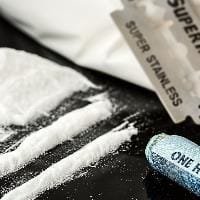(LISBON) – Increase in cocaine availability with seizures at a record high, a near doubling of heroin seizures and high availability of high purity drugs are the stand-out points of the European Drug Report published Tuesday.
The concerns addressed by the ‘European Drug Report 2020: Trends and Developments’, published by the European Monitoring Centre for Drugs and Drug Addiction (EMCDDA), include high availability across all drug types, drug production within Europe and highly potent substances.
The EMCDDA’s latest annual review agency describes the drug situation at the end of 2019, along with recent changes brought by the COVID-19 pandemic in early 2020.
New developments highlighted in the report include a scaling up of synthetic drug production; and concerns around high-potency cannabis, new synthetic opioids and ecstasy tablets containing high levels of MDMA.
The report also reviews COVID-19 disruption to drug use and the market, which could have long-term implications for Europe’s drug services and law enforcement agencies.
There are fears that innovative drug distribution models developed during lockdown, along with the economic impact of the pandemic on vulnerable communities, will add to the challenges already posed by an abundant supply of drugs.
“The operation of lucrative drug markets by organised crime groups, and the record levels of cocaine and high volumes of heroin seized, highlights the persistent threat presented by criminals seeking to exploit supply chains, shipping routes and large ports to traffic drugs,” said Home Affairs Commissioner Ylva Johansson: “The increased availability of all types of illicit drugs exacerbates the health risks.”
Europe’s drug situation up to 2020: highlights
The following ‘Key issues’ have been identified in this year’s analysis:
Large drug shipments are increasingly intercepted A rise in the seizure of large quantities of cocaine, cannabis resin and, increasingly heroin, transported by sea, raises concerns around organised crime groups infiltrating legitimate supply chains, shipping routes and large ports.
Cocaine’s role in Europe’s drug problem is increasing Cocaine purity has increased and more people are entering treatment for the first time. Cocaine seizures are at an all-time high (181 tonnes, 110 000 seizures).
Potential for increased heroin use and existing harms raise concerns The volume of heroin seized in the EU nearly doubled between 2017 and 2018 (rising from 5.2 to 9.7 tonnes) and there are continued reports of some heroin manufacturing within the EU. This suggests that more vigilance is needed to detect any signs of increased consumer interest in this drug. Access to opioid substitution treatment remains limited in some countries.
Understanding the public health impact of high-potency cannabis and new products – Cannabis resin and herb now contain, on average, around twice as much THC as they did a decade ago. This calls for close monitoring of the market at a time when new forms of cannabis are also appearing (e.g. concentrates, edibles).
Increased and diverse drug production within Europe – Established and new drugs continue to be produced in Europe for local and global markets, with more laboratories and production sites detected and a more diverse set of chemicals used.
Continuing availability of high-strength MDMA products highlights need for greater user awareness – Innovation and scaling-up of synthetic drug production in Europe is evident in the continued availability of high-content MDMA tablets and high-purity powders, which pose considerable health risks for consumers. This underlines the need for interventions that tackle drug use harms in recreational settings.
Growing complexity in the drug market poses regulatory challenges and health risks – Less-common and uncontrolled substances appear to be a growing problem in some countries, with more ketamine, GHB and LSD being seized and concerns over the use of nitrous oxide (laughing gas) and new benzodiazepines.
Need for new tools and innovative strategies to support the scaling-up of hepatitis C treatment – Scaling up access for people who inject drugs to prevention, testing and treatment for hepatitis C is critical for eliminating the infection in this group. The introduction of better diagnostic and surveillance techniques to identify those chronically infected is important for targeting treatment.
Drug overdose is increasingly associated with an ageing population – Overdoses in the 50-plus age group increased by 75% between 2012 and 2018; an estimated 8 300 overdose deaths occurred in the EU in 2018. Opioid overdose deaths can be prevented through the timely administration of naloxone.
New psychoactive substances (NPS) have become a more persistent problem – Over the past three years, NPS have been detected for the first time in Europe at the rate of around one per week; 53 substances were detected in 2019.
Appearance of novel synthetic opioids is a worrying example of continuing market adaptability – Eight uncontrolled new synthetic opioids, some from diverse and new groups, were detected for the first time in 2019, raising fresh public health concerns.
COVID-19 disruption: challenges
Many drug services were forced to close, or limit their offer, in the early lockdown period but managed to adapt and innovate (e.g. via telemedicine) to provide rapid access to treatment and other support. The initial impact of the crisis on patterns of drug use was mixed, with signs of declining interest in substances that are commonly used in social settings (e.g. MDMA, cocaine) but apparent increased use of other substances in some groups (e.g. cannabis, new benzodiazepines). Initially, supplies of substances on local drug markets were disrupted, resulting in shortages and higher prices, but this may revert as social distancing measures are relaxed.
The report also reveals how organised crime groups quickly adapted their modi operandi, particularly at retail level. With street dealing affected by restrictions on movement, consumers and dealers turned to the use of online darknet markets, social media platforms and parcel and home delivery services. Monitoring of the drug market suggested that, at wholesale level, smuggling by air passenger transport declined, but trafficking by maritime shipping continued at pre-pandemic levels. Synthetic drug production and cannabis cultivation in Europe also did not appear to be seriously affected.








